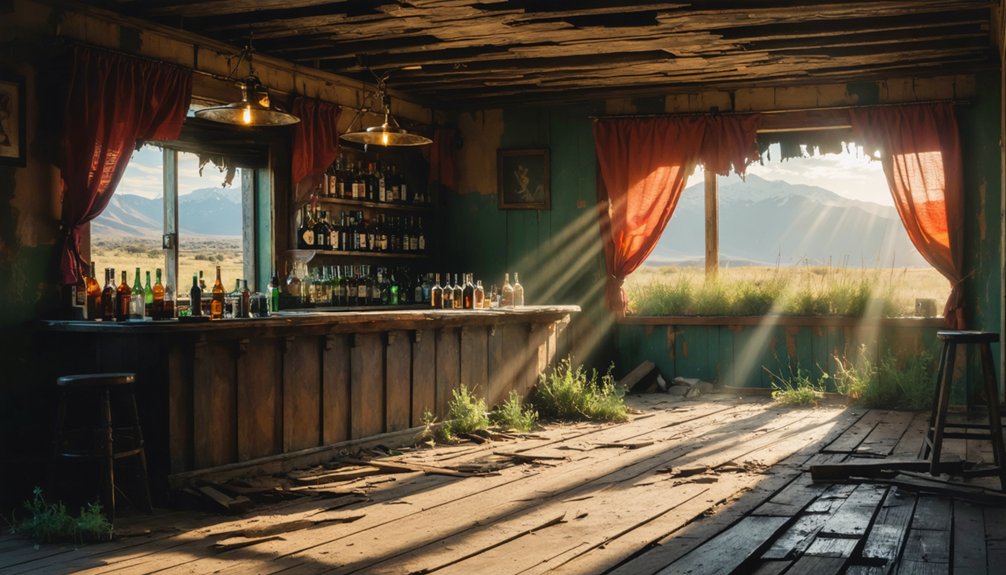St. Louis, California began as a prosperous Gold Rush settlement founded by Missourians in northern Sierra County at 1,299 feet elevation. You’ll find it was once home to 900 residents who established mining operations, businesses, and informal justice systems. Multiple devastating fires, the Civil War’s economic impact, and depleting gold reserves triggered its abandonment by the early 1900s. Only foundations remain today, marking the boom-and-bust cycle that defined California’s mining frontier.
Key Takeaways
- St. Louis was an early California Gold Rush settlement founded by Missourians in Sierra County at 1,299 feet elevation.
- Devastating fires, particularly the 1858 fire that destroyed most buildings except the bank, weakened the economic foundation of the town.
- Population declined from 900 residents to near abandonment within a decade, accelerated by the Civil War’s impact on workforce.
- The post office closed twice (1895 and 1915), marking the official transition from bustling mining town to abandoned ghost town.
- Only foundations remain today, serving as a historical reminder of California’s boom-and-bust mining culture and resource-driven settlement patterns.
The Birth of a Mining Settlement in Sierra County
As the California Gold Rush fever spread northward in 1849, St. Louis emerged as what many believe was the earliest mining town in northern Sierra County. Founded by determined Missourians, this frontier settlement quickly established itself on mineral-rich terrain at an elevation of 1,299 feet.
You’d recognize the typical mining community dynamics immediately – initial structures included basic miner housing alongside storage facilities for essential supplies. Property claims were staked by early arrivals, with the settlement pattern developing around ideal mining locations.
Mining techniques evolved as prospectors sank shafts and drove adits into promising hillsides. The absence of central authority created a volatile environment where miners established their own justice systems. Similar to the Furnaceville settlement that formed around the reverberatory furnace in 1875, mining operations often sparked the development of supporting communities.
Competition for resources often sparked tensions between different groups, reflecting the freedom and lawlessness that characterized California’s gold country. Like the early settlers of St. Louis, Missouri who received verbal land grants from Pierre Laclede in 1764, these miners often relied on informal agreements for property rights.
Gold Rush Origins: How Missourians Named a California Town
You’ll find St. Louis, California’s naming directly linked to the Missouri Gold Fever that swept prospectors westward in the late 1840s.
Missouri settlers, particularly from St. Louis—a pivotal Gateway to the West—carried their hometown’s name as they established new communities in the gold fields.
This namesake mining community emerged as Missourians sought to create familiar surroundings while pursuing fortune in California’s Sierra County. As part of the approximately 300,000 people who migrated to California during the gold rush, these Midwesterners brought not only mining ambitions but cultural identities that shaped the region’s development. Historical accounts like Charles Peck’s diary documented the challenging journey westward that these settlers undertook to reach the promised lands of California’s gold territory.
Missouri Gold Fever
Missouri miners caught gold fever quickly.
St. Joseph became the primary departure point, with wagon trains stretching for miles down Francis Street.
The 2,000-mile journey west took 4-5 months, with merchants competing to outfit pioneers with supplies. The news of gold’s discovery spread rapidly through newspaper coverage, prompting massive migration to California. Many travelers suffered from cholera outbreaks along the heavily trafficked Platte River Trail.
Gateway to West Connection
While St. Louis, Missouri served as the literal gateway to western expansion, its influence extended beyond geography into cultural identity.
As you trace the origins of the California ghost town‘s name, you’ll find Missouri’s imprint firmly established during the Gold Rush era. St. Louis’s influence manifested when Forty-Niners departed from its riverbanks, carrying not just supplies but also their cultural heritage. When Kit Carson arrived in Saint Louis on July 24, 1848, gold discovery rumors were just beginning to circulate throughout the region. The arduous journey that followed often began at key Missouri departure points like Independence and St. Joseph, where wagon trains formed to cross the continent.
These Missouri migrants created psychological connections to home by naming their new California settlements after familiar places. The practice served as a symbolic gateway linking their past to an uncertain future.
What you’re witnessing in these toponyms is more than nostalgic labeling—it’s the transplantation of Midwestern identity onto California soil. This naming convention reflected both the predominance of Missouri emigrants and their enduring impact on California’s cultural landscape.
Namesake Mining Community
Amid the feverish excitement of California’s Gold Rush era, St. Louis emerged when Missouri miners staked their claims in the golden hills of Northern California.
These fortune-seekers, having departed from St. Louis, Missouri—a major gateway for westward expansion—named their new settlement after their hometown.
You’ll find that these Missourians brought more than just dreams; they introduced established mining techniques like placer mining and “coyoteing” that shaped how gold was extracted throughout the region.
Their influence extended beyond mere resource extraction, as they created a community that mirrored their origins.
The settlement became a cultural hub for Midwestern migrants, with businesses and social gatherings reflecting Missouri sensibilities. Like many during the rush, most of these hopeful miners ultimately lost wealth due to high living costs and the challenges of frontier life.
These cultural legacies provided comfort and familiarity for those far from home, creating a distinct Missouri identity amid California’s diverse mining landscape.
Weekend Gold Trade and Social Life
Despite the mining operations slowing during weekdays, the St. Louis mining community transformed dramatically each weekend.
Historical records about this specific ghost town‘s weekend activities are unfortunately sparse in available research. Historians believe that like similar California mining settlements, St. Louis likely hosted social gatherings where miners exchanged their weekly findings, traded supplies, and participated in mining festivals that celebrated their collective efforts.
While specific weekend customs remain undocumented, St. Louis miners likely gathered to trade gold, share supplies, and foster community through celebratory festivals.
These weekend events would have provided essential social connections in an otherwise isolated existence. The absence of detailed documentation about St. Louis’s weekend gold trade and social activities highlights the challenge of preserving the complete history of California’s numerous mining communities. Visitors today can explore the site, though many express disappointment at the poor maintenance and limited access to buildings.
Further archaeological and historical research would be necessary to uncover the authentic social dynamics of this particular ghost town.
Economic Ecosystem of a Mining Hub
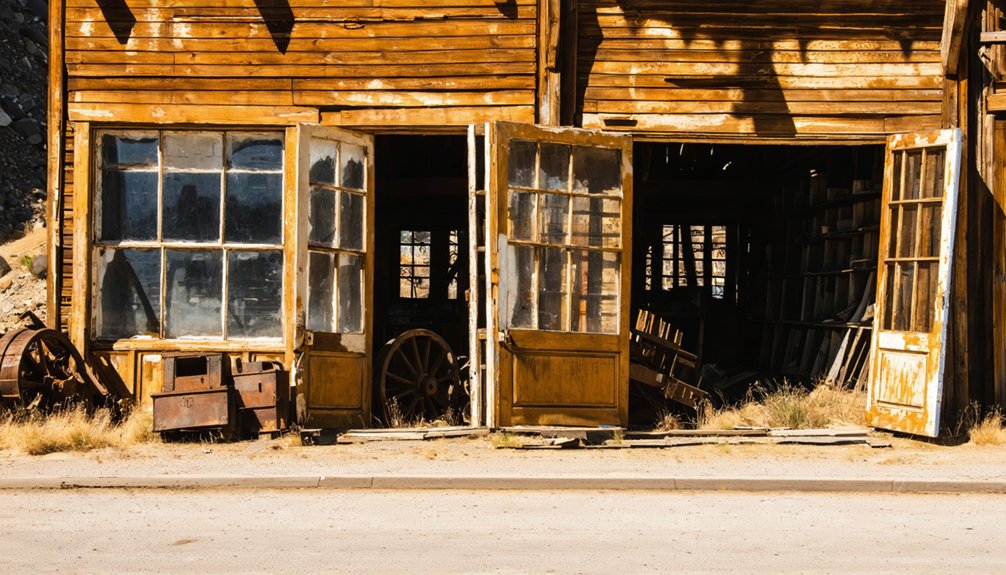
St. Louis’s economic ecosystem revolved around a complex network of mining enterprises and support businesses. You’d find placer mining as the dominant technique, with miners using sluice boxes and quicksilver to separate gold from sediment during the warmer months.
As surface gold depleted, mining techniques evolved toward more advanced methods like dredging by the 1890s.
Labor dynamics shifted noticeably through the decades. Initially dominated by independent prospectors, the industry gradually changed to company employment as extraction became more capital-intensive.
While miners earned about $18 per ounce for purified gold, merchants consistently outearned them by selling essential supplies at premium prices.
The town’s infrastructure expanded to accommodate this economy, with specialized shops, transportation networks, and seasonal services developing to meet the demands of a growing mining community.
Devastating Fires and Rebuilding Efforts
You’ll find the 1858 fire’s aftermath particularly striking, as it reduced nearly the entire settlement to ashes within hours, leaving only the bank and a single store standing.
Residents quickly embraced fireproof construction techniques, utilizing locally available stone and incorporating iron doors to protect against future disasters.
Despite these adaptations, the community struggled to recover economically, as fire insurance remained unavailable and many miners, already facing seasonal constraints, lost their accumulated gold deposits during the conflagration.
1858 Fire’s Aftermath
While the small mining community of St. Louis struggled to recover from successive devastating fires, the psychological and economic impacts proved far-reaching.
You’d witness profound changes in community behavior following each blaze, with residents developing heightened fire safety awareness and nightmares plaguing survivors. The store owner who prioritized firefighting over opening his safe would awaken shouting “Fire!” for months afterward.
Community resilience weakened as miners abandoned claims after each conflagration.
With gold production decreasing considerably after the 1863 fire, economic stagnation took hold. The town’s repeated destruction discouraged new construction and investment in permanent settlements.
Fireproof Construction Techniques
Following the successive disasters, St. Louis residents implemented innovative fireproof construction techniques. In 1853, two fire-resistant buildings were erected using stone and brick—materials considered cutting-edge for fire safety at the time.
These structures featured simplified rooflines and non-combustible exterior walls to minimize vulnerability.
Despite these efforts, the town was completely destroyed on September 1, 1854, proving even “fireproof” buildings had limitations. This catastrophe taught valuable lessons about ember resistance that inform modern rebuilding strategies.
Today’s approaches focus on eliminating all potential ember entry points through sealed vents, fire-rated glass, and continuous non-combustible layers from exterior to interior.
Metal roofing, copper cladding, and Venetian plaster finishes create maintenance-free, fire-resistant structures that would have been unimaginable to the original St. Louis settlers.
Economic Recovery Struggles
The economic aftermath of successive fires in St. Louis devastated the town’s financial foundation.
You’ll notice how these disasters destroyed essential commercial buildings, slashing rental income and tax revenues while insurance payouts fell woefully short of covering actual losses.
Economic revitalization efforts faced numerous obstacles: funding shortages, approval delays, labor scarcity, and increased construction costs extended recovery timelines.
Property values plummeted by over 90% in some buildings, creating a cycle of underinvestment and market deterioration.
Despite government tax incentives and proposed legislation like the Revitalizing Missouri Downtowns Act, investment challenges persisted.
Bureaucratic complexities hampered rebuilding programs while pandemic effects further reduced downtown activity.
Though downtown population has doubled since 2010, commercial recovery remains uneven, with abandoned buildings contributing to the area’s ghost town appearance.
Seasonal Challenges: Mining Through Sierra Nevada Winters
As heavy snowfall blanketed the Sierra Nevada mountains each winter, St. Louis miners faced brutal conditions at 2,700 feet elevation.
You’d witness temperatures plunging below freezing, causing water sources to freeze and halting hydraulic operations that were the town’s lifeblood. These winter hardships threatened more than productivity—avalanche risks increased, daylight shortened, and tools became difficult to handle.
Workers developed mining adaptations to survive. They shifted to subterranean hardrock mining when hydraulic methods stalled, built communal heating fires, and improved drainage systems to address freezing issues.
Miners innovated survival strategies—switching to underground operations, sharing warmth, and engineering solutions for winter’s frozen grip.
Despite these innovations, many miners migrated seasonally to milder climates.
The economic impact was severe. Mining output fluctuated dramatically, with summer months needed to offset winter inactivity—a cycle that contributed to St. Louis’s eventual decline after the 1884 hydraulic mining restrictions.
Civil War Impact on Mining Population
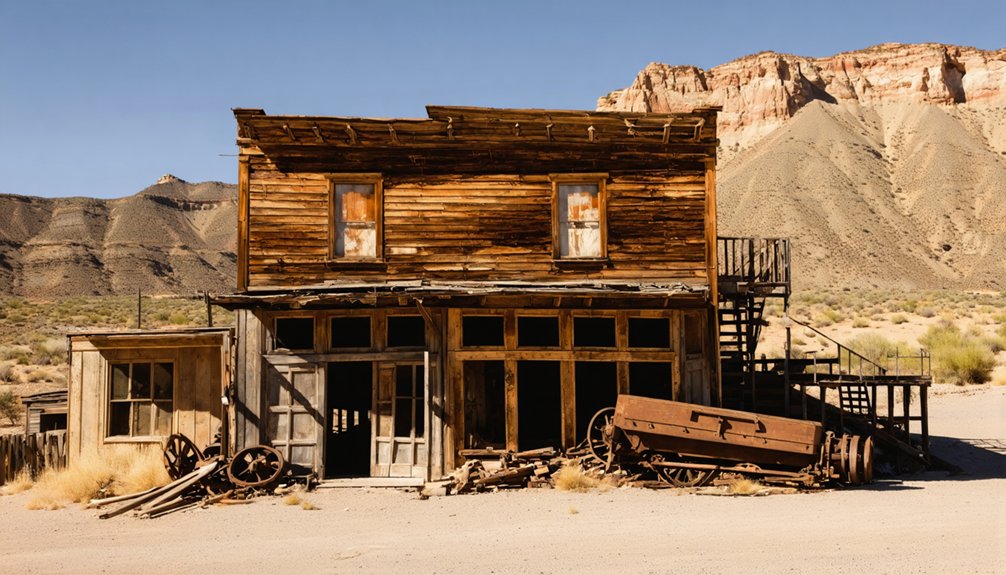
While miners battled Sierra Nevada’s harsh winters, an even greater national crisis loomed that would forever alter St. Louis. The Civil War triggered unprecedented economic disruption as miners abandoned their claims to join the conflict.
The war’s impact manifested in three devastating ways:
- Military conscription dramatically reduced the workforce, leaving mining operations unmanned and deteriorating.
- Gold production plummeted as weekly washing operations ceased, crippling the town’s economic foundation.
- Two major fires (1858 and 1863) destroyed most buildings, with reconstruction efforts hampered by wartime labor shortages.
You can trace St. Louis’s transformation from bustling gold town to ghost town directly to this period. Without miners depositing gold, gambling at saloons, or requiring services, the population dwindled from 900 residents to near abandonment within a decade.
Evolution of Commerce and Supply Chains
Early commercial activity in St. Louis began with fur trading networks established by pioneers like Pierre Laclede and Auguste Chouteau, who built relationships with Native American groups, particularly the Osages.
These initial supply chains expanded dramatically after 1817 when the steamboat Zebulon M. Pike arrived, revolutionizing transportation evolution and positioning St. Louis as a crucial navigable river port.
The 1820s-30s saw wholesalers, banks, and retailers flourish as steamboats facilitated the movement of goods to western territories.
Mining operations relied on complex supply chains that transported essentials over challenging terrain.
Local entrepreneurs adapted by creating multifunctional businesses that combined ferry services, postal operations, and Wells Fargo agencies.
These integrated transportation networks—including river ferries charging specified rates—became essential commercial arteries connecting isolated settlements to larger markets, enabling efficient distribution of mining supplies.
The Gradual Abandonment of St. Louis
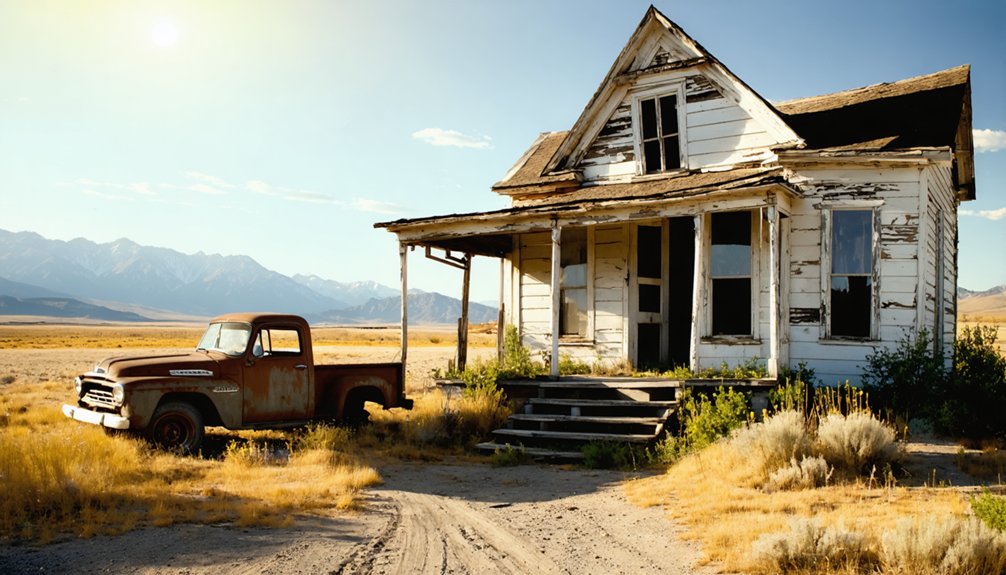
You’d find St. Louis emptying each winter as deep snow made mining impossible, but the town’s permanent decline began after the Civil War drew away miners who never returned.
The devastating fires of 1863 destroyed nearly all structures except two fire-proof houses, leaving insufficient capital for proper reconstruction.
Post office closures in 1895 and again in 1915 marked the official milestones of St. Louis’s transformation from bustling mining settlement to abandoned ghost town.
Harsh Winter Exodus
As winter descended upon St. Louis, the already struggling mining town faced its final death knell.
The harsh winters of 1915-1916 accelerated the population decline that had begun years earlier as gold reserves depleted. You’d have witnessed families packing their remaining possessions, abandoning homes that could no longer sustain them.
The exodus followed a predictable pattern:
- Wealthier merchants departed first, closing shops that served a dwindling customer base.
- Mining families left next as hydraulic operations destroyed what remained of local infrastructure.
- The final holdouts fled when winter conditions made survival impossible in damaged structures.
Civil War Impact
The Civil War struck a devastating blow to St. Louis. As the conflict erupted, miners abandoned their claims in droves, causing the population to plummet from its peak of 900 residents.
The town’s divided loyalties mirrored Missouri’s larger political fractures, creating intense civil unrest as Union supporters clashed with Confederate sympathizers.
Economic decline followed swiftly as gold production decreased dramatically. With miners fleeing and capital investment drying up, local businesses shuttered.
Confederate naval actions disrupted crucial supply routes, further isolating the struggling community.
Union troops and militia enforcement created an atmosphere of paranoia, with loyalty tests, fines, and imprisonments becoming commonplace.
The psychological toll of militarization, combined with fears of attacks and slave uprisings, accelerated the exodus as residents sought safer, more stable communities elsewhere.
Post-Fire Reconstruction Failures
Fire devastated St. Louis in 1854, leaving just three structures standing. The town’s reconstruction challenges proved insurmountable, particularly as mining activities had already begun declining.
You’ll find the aftermath characterized by profound economic stagnation and abandonment rather than renewal.
The reconstruction failures stemmed from:
- Severe funding shortages that prevented even basic rebuilding of commercial and residential structures
- Mass exodus of residents who relocated to more promising mining communities
- Complete absence of organized town planning or development initiatives
Without proper investment or infrastructure, surviving businesses couldn’t sustain themselves. The few rebuilding attempts were piecemeal and inadequate, leaving the town in perpetual disrepair.
Buildings deteriorated as the population continued to dwindle throughout the late 1850s. What might’ve been rebuilt instead became a ghost town, surrendering to the inevitable forces of time and neglect.
Legacy and Historical Significance in California’s Mining Era
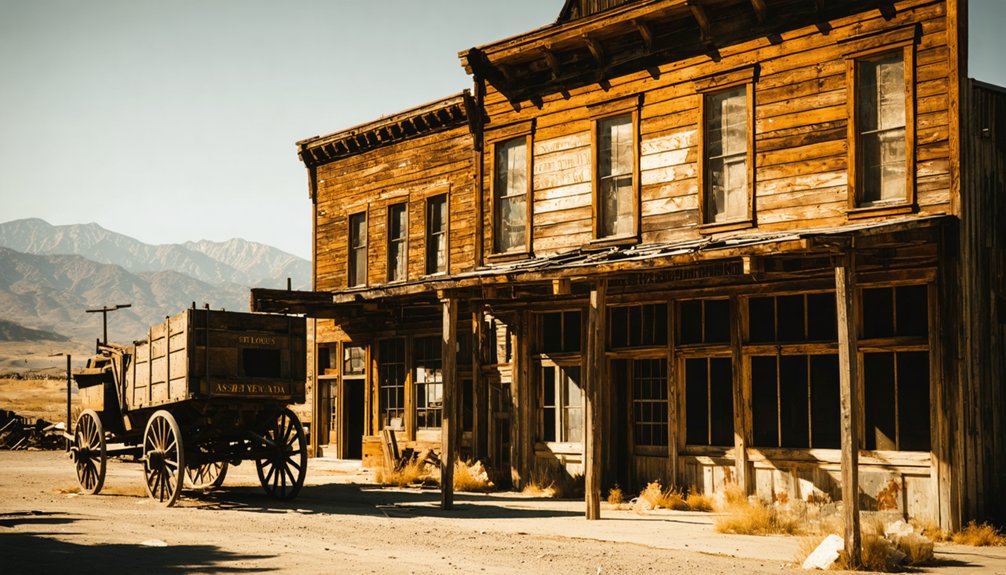
St. Louis stands as a representation of California’s boom-and-bust mining culture, representing an authentic piece of American cultural heritage.
When you visit the scattered ruins today, you’re witnessing the remnants of a once-thriving community that embodied the pioneering spirit of the Gold Rush era.
Founded in 1850 by prospectors Haven and Wilcox, the town exemplifies how mining technology and gold extraction shaped California’s development.
At its peak, nearly 900 residents called this Sierra County settlement home.
Now mostly abandoned, with only foundations and depressions marking its former layout, St. Louis preserves the memory of frontier mining life.
Its significance extends beyond physical remains, serving as a poignant reminder of resource-driven settlement patterns that defined California’s formative years.
Frequently Asked Questions
Are There Any Remaining Structures Visible at the Site Today?
No, you’ll find no intact remaining buildings at the site today. Only scattered foundations and partial walls persist, quietly preserving the historical significance of this once-thriving mining community.
What Valuable Artifacts Have Been Discovered in the Ghost Town Ruins?
You’ll find gold coins dating to the 1860s among the valuable artifacts discovered. These items hold significant historical context, revealing the economic prosperity and daily lives of frontier miners seeking freedom.
Can Visitors Legally Explore or Metal Detect in St. Louis?
You can explore but metal detecting isn’t permitted without authorization. Follow posted safety guidelines when visiting. Check ownership boundaries first, as public lands have stricter rules than private areas.
Were Any Famous Historical Figures Associated With This Town?
Absolutely zero famous historical figures ever graced St. Louis! Unlike its Missouri namesake, this California ghost town gained historical significance through ordinary miners like P.A. Haven and Harvey Wilcox, not celebrated famous residents.
How Does One Access the Ghost Town’s Precise Location?
You’ll need to locate St. Louis through historical maps and GPS navigation. First, research coordinates in county archives, then input them into your device for precise directions to this remote site.
References
- https://www.legendsofamerica.com/mo-stlouis/
- https://westernmininghistory.com/towns/california/st-louis/
- https://en.wikipedia.org/wiki/Times_Beach
- https://touristlife.online/en/bodie-ghost-town-abandoned-ghost-town-in-california/
- https://thevelvetrocket.com/2012/01/25/california-ghost-towns-st-louis/
- https://www.youtube.com/watch?v=B9u9AXlDKEc
- https://savingplaces.org/guides/ghost-towns-on-route-66
- http://exploringshastahistory.blogspot.com/2021/06/
- https://www.museum.state.il.us/RiverWeb/landings/Ambot/Archives/History69/index.html
- https://dpul.princeton.edu/rose-early_grass-scarce/feature/so-goes-california-the-gano-family-gold-rush-scrapbook
